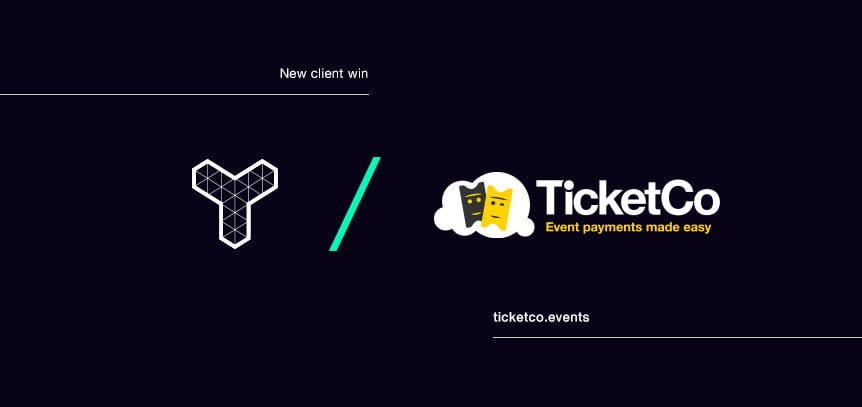
The definitive guide to SaaS pricing models
The pricing model your organisation picks affects the success of your go-to-market strategy. Learn more about them in this article.
Pricing models are an essential part of all marketing strategies, but when it comes to SaaS products, they’re especially key.
Because software is physically intangible, companies must put in the extra effort. This is to ensure that the price of their offering aligns with the value and expectations of their target audience.
In this article, we’ll share the pros and cons of each subscription pricing model. We’ll also provide tips on how you can choose the right one for your business.
What are the benefits of choosing the right SaaS pricing model?
Having the right SaaS pricing model can help your product stand out, especially if you’re competing in an existing competitive market (also known as a ‘red ocean’). It may also improve your customer acquisition rates, which could make a huge difference to your revenue.
What’s more, your pricing model affects the way potential customers see your SaaS product. In other words, it heavily influences the success of your product positioning.
Many businesses position their product as a cheaper solution to their competitors’ software, but with the same benefits. This is known as ‘same-for-less’ positioning. Others opt for a ‘more-for-less’ strategy instead, meaning the buyer receives more product benefits by paying a lower price.
Without an appropriate pricing model, neither strategy is effective. This is because potential customers won’t be able to clearly see your value proposition.
What are the main types of SaaS pricing models?
Flat-rate pricing
There is probably no simpler way to sell a SaaS solution than flat-rate pricing. With this subscription model, you provide a single product, a single set of features, and a single price. Typically, you’ll charge users a flat fee per month or year for access to all your software features.
Technology has allowed SaaS companies to develop scalable pricing structures, so flat-rate pricing is quite rare. This model is more commonly used by companies in B2C markets, especially those that sell physical products. Still, there are some notable exceptions (but more on that later).
Advantages of flat-rate pricing
There are a few clear benefits of flat-rate pricing. Perhaps the most obvious advantage is the fact that your product is easier to sell.
Offering a single product at a single price makes it easy for your organisation’s marketing team to focus all of their efforts on promoting one clear offering.
Your sales team will also be able to communicate your product’s value more effectively and efficiently. After all, SaaS pricing models can get quite complicated. Flat-rate pricing, however, can be understood by any prospective customer—instantly. By removing the potential fear that they might pick the wrong pricing tier, you also reduce the time buyers typically take to make a purchase.
Another advantage you should consider has to do with your business metrics. A simple fixed price means your churn rate and revenue growth will be easier to predict.
Disadvantages of flat-rate pricing
With flat-rate pricing, you’ll be limited in a few ways. Firstly, you’ll have little to no upselling capabilities because there’s only one pricing tier; this can severely limit revenue.
Secondly, your marketing strategy has to stay relatively rigid. In contrast to a tiered SaaS financial pricing model, you only have one shot to land the customer.
Many of them may not even need to use all of your software features, so making them pay for the full package could lead them to believe that they’re not getting enough value for their money. And if customers think your software is too expensive, there’s little you can do to sway their opinion.
There’s also the challenge of extracting value from various users. For example, if small businesses are a part of your target audience, you may use a low-cost pricing strategy. However, this means you’ll miss out on a lot of potential revenue from enterprises and corporations because they would have to pay the same price as small businesses.

Example: Basecamp
Basecamp is a prime example of flat-rate pricing being used to great effect. This is because their model plays a key role in their overall positioning strategy. Unlike their competitors, they sell their software for $99 a month—and that’s it. This kind of simplicity is extremely powerful and effective.
Usage-based pricing
Usage-based pricing, also known as the Pay As You Go model, directly links the cost of a SaaS product to how often it is used. If someone uses more of your software, their bill goes up. If they use it less, their spending goes down.
This pricing model is commonly used by infrastructure or platform-related companies, where companies are billed for API requests, transactions, and gigabytes of data used.
Advantages of usage-based pricing
Usage-based pricing is very appealing to prospects and existing customers, so it’s easy to sell. It takes their changing demand for your software into account. After all, if you used an expensive service less often than usual, why should you want to pay the same high amount?
With usage-based pricing, upfront costs are minimal so even reluctant prospects can sign up and get started with your product. Small start-ups can easily benefit from this model.
It also covers heavy user costs. Fixed-price packages carry the risk of an unbalanced distribution of resources to heavy power software users who don’t compensate for it with increased spending. Having a flexible pricing model can prevent this.
Disadvantages of usage-based pricing
One major disadvantage of usage-based pricing is low switching costs. With no fixed contract, users need very little upfront commitment. This makes it easy for them to instantly switch to your competitors, which would negatively impact your customer churn rate.
Another related reason is the difficulty of forecasting your revenue. The flexibility of this model means that billing amounts change every month, making it hard to predict how well you will do by the end of a certain quarter.
This also applies to your customers. With this model, there’s always a risk of ‘sticker shocks’, which means users may use your software and experience overnight success—leaving them with an expensive and unexpected bill.
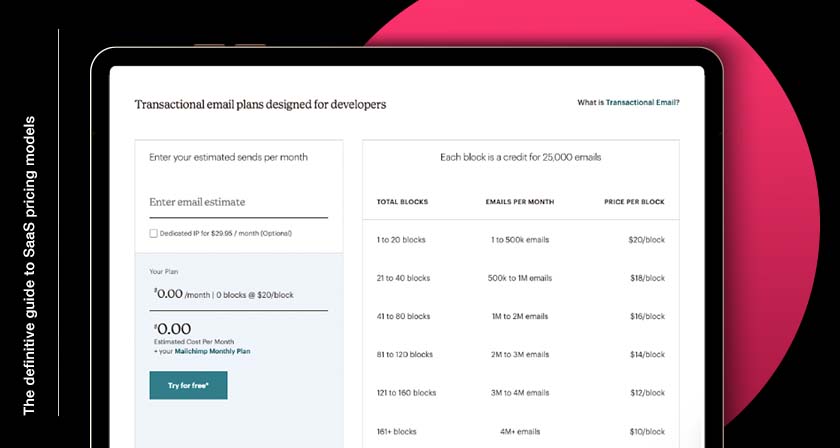
Example: Mailchimp
Mailchimp is an email marketing platform that charges businesses on the number of emails they send. Users can enter an estimate of how many emails they plan to send per month. This model helps ensure a certain level of predictability by ensuring that customers can afford the service—and that the price paid is justified.
Tiered pricing
Compared to flat-rate and usage-based pricing, tiered pricing is much more common. In fact, it’s the de facto model for most SaaS companies.
With tiered pricing, different combinations of features can be offered at different price points (for most companies, the number is three). Usually, there’s a base-level tier, which is the cheapest level. The ones above it offer some additional features that would otherwise be locked behind the base level.
Advantages of tiered pricing
The tiered pricing model offers plenty of opportunities for upselling. If a customer outgrows their current software package, you can easily reach out to users of your lower-tier services and persuade them to upgrade their subscription level; in the world of SaaS, this often contributes to a significant chunk of your revenue.
Equally, if a potential customer isn’t interested in the features of your top tier package, you can convince them to opt for your base-level service instead. This way, you still keep that customer. This wouldn’t be possible if you used a flat-rate or usage-based model, for instance.
Tiered pricing also gives you the flexibility to market to multiple personas. You can tailor your software packages to suit the needs of various types of customers, whose willingness to pay may differ.
Disadvantages of tiered pricing
Tiered pricing can be potentially confusing. When using this type of model, it’s important to make sure that everything is easy to understand. Otherwise, you’ll leave prospects confused or overwhelmed, making it less likely for them to sign up.
Another potential disadvantage is heavy user risk. It won’t be possible for you to collect extra revenue to compensate for top tier users if they regularly exceed their allocated service usage.
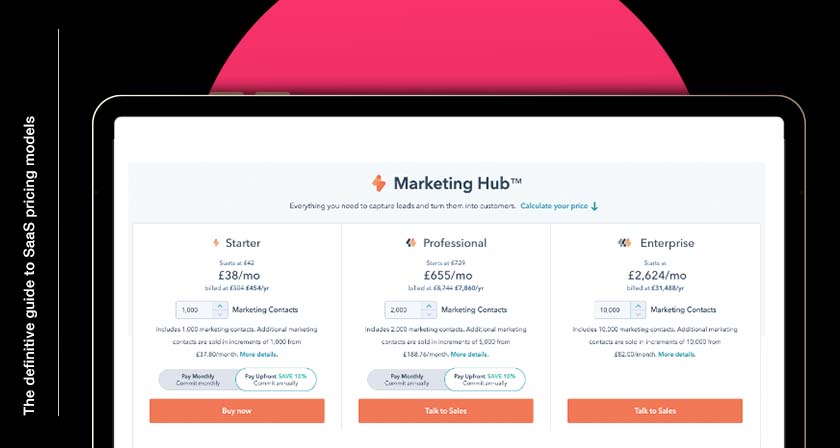
Example: Hubspot
A popular example of tiered pricing can be seen in Hubspot. Each tier revolves around the needs (and budget) of a different type of customer, ranging from ‘starter’ to ‘professional’ and ‘enterprise’.
Per-user pricing
Another popular SaaS pricing model to know about is per-user pricing, which allows you to charge based on the number of users under a particular account. For instance, one of your buyers may be a corporation with over 5,000 employees who will be using your software; another may be an entrepreneur. In this model, you’ll charge them differently.
Advantages of per-user pricing
A major benefit of per-user pricing is scalability. As organisations naturally grow, there will be more individuals who need to use your software. More users onboarding means predictable revenue.
In addition, this model can be easily understood by customers as well as your team. To calculate how much a certain customer has to pay, all they need to do is look at the headcount. This greatly simplifies the sales process.
Disadvantages of per-user pricing
One major downside to this SaaS pricing model is the additional barriers to adoption. Charging by the number of users means giving organisations an incentive to pay less. Some companies, in an effort to cut costs, will limit the number of team members using your product. Others may even ‘cheat’ by encouraging their employees to share logins and passwords.
Another potential issue with per-user pricing is the disconnect between the price and the value of your product. This can hinder perceptions of your brand in the long term.
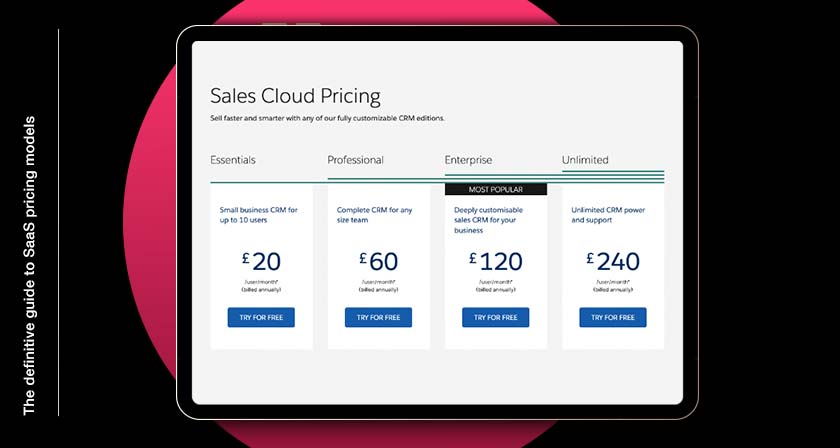
Example: Salesforce
Salesforce’s Sales Cloud is an online tool that helps sales teams manage leads better and faster. As you can see, customers are charged on a per-user basis.
Freemium pricing
Freemium pricing is a widely-used pricing model that allows businesses to entice users with a free but limited version of their product. By hooking users into your product, you can nudge them to upgrade to the full-featured paid version in the future. This model is usually used in combination with tiered pricing.
Advantages of freemium pricing
One clear benefit of freemium pricing is lower customer acquisition costs (CAC). A significant challenge that all SaaS businesses face is initial product adoption; this model, however, makes it very enticing for customers to sign up. You also open up the possibility of your software becoming viral (because of frequent user referrals).
Upselling is also easy. With freemium, the people you want to convert into paying customers are already users of your software. This means they’re more likely to appreciate the value of your product.
Disadvantages of freemium pricing
Freemium is a very appealing model to prospective users of your software, but to SaaS companies, it’s not very profitable (especially when used on its own). Free users won’t generate any revenue for your company, which means there is added pressure to convert as many of them as possible to paid users. These paid users must generate enough revenue to cover the cost of acquiring your free users.
What’s more, customers are more likely to churn. Because there are no switching costs, people who use your software for free are more likely to have a ‘throwaway’ mindset, which can make your SaaS product appear less valuable. Building brand loyalty often can also be a challenge.

Example: Canva
Canva is an online graphic design tool that helps businesses create engaging visual content. The software is free to use, but many features (like unwatermarked designs) are only available to paying customers.
Free trial pricing
Free trial pricing is fairly self-explanatory. Unlike freemium pricing, this model allows users to access all of your software’s features, but only for a limited time. It’s worth noting that free trials tend to only play a supplementary role in SaaS organisations’ pricing strategies. Most of the time, they work in combination with another model.
Advantages of free trial pricing
Free trials are an integral part of many SaaS pricing strategies, and it’s easy to see why. They’re an excellent way for the user to test your software without taking on any risk. This can be a fantastic starting point for them to become regular paying customers.
This pricing model also allows you to gather a lot of data from prospects. Usually, your would-be users have to submit their contact details to activate their free trial. These details can inform your marketing communications campaigns.
Disadvantages of free trial pricing
It takes a lot of time and resources to convert free users to paying customers.
The learning curve for many SaaS tools is steep, and your team needs to speed up the process to get users to see the value of your product—before their trial expires. If you don’t have enough organisational resources to do this, it may not be worth the effort.
And of course, this pricing model can be open to exploitation (after all, anyone with more than one email address can sign up for multiple free trials!).
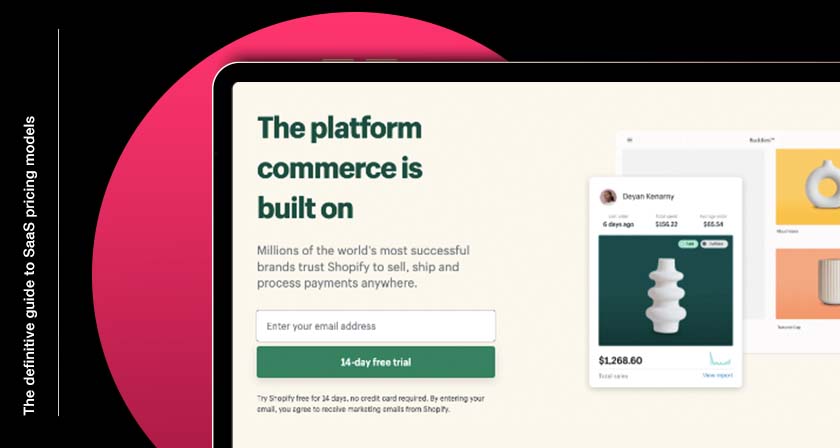
Example: Shopify
Shopify is an e-commerce platform that helps retailers sell, ship and process payments. With a 14-day free trial, businesses can set up their shop and choose how to pay later.
How should companies pick the right pricing model?
Your company must first consider the findings of your market research and competitive analysis before it can choose the right pricing model. This means getting an in-depth understanding of your target customers and other software solutions on the market.
Establishing a clearly-defined set of customer personas is the first step to this. This can be used to determine who your customers are and how much they’re willing to spend.
If you have multiple target segments with wildly different needs, a tiered pricing structure (combined with a freemium model) may work well. But if your product is only meant for one persona, a flat-rate model can keep things simple and effective.
You may also consider how fast your buyers’ organisations are growing. If they’re trading in a fast-growing market, a per-user model can be very lucrative.
Whichever pricing model your company chooses, make sure you know what your CLV to CAC ratio is. This will help you decide if a model is financially viable in the long term. Ideally, your ratio should be about 3:1. You never want your customer acquisition cost to be higher than your customer lifetime value!
One last tip: pricing isn’t something you set and forget. You’ll need to revisit your SaaS pricing a few times a year to make sure it still reflects the value you provide. If you believe a change is needed, consult other departments in your organisation for their input.
Key takeaways
- It’s important to pick the correct pricing model for your SaaS organisation because it helps you stay competitive. Plus, it makes your product positioning more believable.
- Flat-rate pricing involves selling a set of features for a single price.
- Usage-based pricing links the price you pay for a software platform to how often you use it.
- Tiered pricing mixes and matches different combinations of features at different price points.
- Per-user pricing charges customers based on the number of active users under a particular account.
- Freemium pricing offers a base-level service for non-paying users, reserving the full set of features for paying ones. Free trial pricing offers all users access to all features, but only for a limited time.
- When you’re thinking about which model to pick, assess how your target customers perceive your product’s value. Other factors to consider include the number of target segments, how fast they’re growing and your CLV/CAC ratio.
Read the latest positioning trends and insights.
Tap into our brand and product positioning, storytelling, and creative expertise to inspire your next strategic move.
